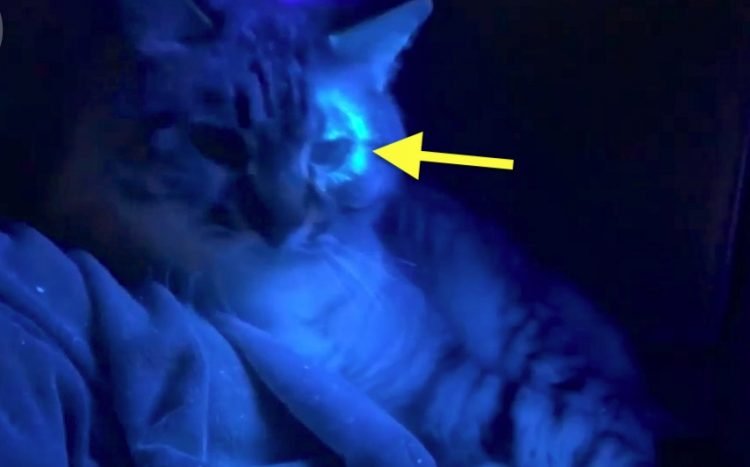We know how contagious ringworm is but how, exactly, is it transmitted? We need to know this in order to manage it. To be honest, it’s quite hard to find out this information in the sort of detail and precision that I seek.

Transmission
The disease is transmitted by contact with spores. These are the spores of a fungus. Most cases are caused by the fungus Microsporum canis. So, there has to be contact with the spores of this fungus. Where are they?
They can be found in the soil. In respect of cats, they will be on the hair. In respect of people, they will be on the skin but are the spores only in the area where the actual infection is (you can see the inflamed skin in a ring) or do the spores travel across the skill of the person and remain invisible?
It appears, in fact, that the spores do, in fact, travel over the skin of the person and therefore when the reference books say that ringworm transmission is by direct contact of the skin (in respect of person-to-person or skin to hair for cats) it does not have to be the area of the skin where the effect of the ringworm is visible, which I think is an important bit of information.
To recap: the obvious form of transmission is by direct contact with either the skin of the person or the hair of the cat and this fungus can travel between the two in either direction. It is not always from the cat to the person. It can be from person to cat.
However, as I see it, the most important and most prevalent method of transmission of ringworm is by contact with spores that have found their way onto carpets, brushes, combs, toys and furniture. This list must also include the clothes of the person who cares for the cat.
That means that the spores could be on any surface in the home or if we are talking about a cat shelter on any surface in the cat shelter. It is this aspect of the transmission of this fungus that makes it very difficult to contain and which makes it particularly contagious, as I see it.
In addition, cats can carry the fungus without showing any apparent infection therefore they are a source of infection without the person knowing about it. The same can be said about people because if a cat has transferred the spores to a person and the person does not show any signs of infection they are still carrying the disease and are a reservoir for it. Children are particularly likely to catch the disease.
Elimination of Spores
Another aspect of this difficult to remove, but rather minor disease, is that the spores can survive for up to one year. This means that in order to eliminate them from premises (to avoid reinfection) a rigourous approach has to be adopted.
This is what is recommended:
- the cat’s bedding should be discarded (thrown away)
- grooming equipment such as flea combs and brushes need to be sterilised in a diluted solution (1:10) of sodium hypochlorite (in America this is Clorox)
- the home should be thoroughly cleaned and the carpet should be vacuumed weekly to remove infected hair.
- hard services should be washed using dilute Clorox
- in America, Technical Captan can be used as a spray at 1 to 200 dilution.
The cat owner’s clothes should be boiled or washed in Clorox to kill the spores. This, I believe, is something that people will find hard to do because boiling clothes and disinfecting them with sodium hypochlorite may damage them – I don’t know, perhaps somebody can advise me on that.
As can be seen, this as a rather rigorous cleaning programme and I think it goes well beyond what cat owners might envisage. I would be surprised if many cat owners were prepared to enter into such a rigourous cleaning and disinfecting program in order to remove their home of ringworm spores.
Treatment of Cat
Mild cases usually regress spontaneously (in other words, they clear up naturally). If a cat has a normal level of immunity then the infection normally won’t come back.
If you can see the area where the infection is, it can be treated with a topical anti-fungal cream. A vet will recommend one. If the infection is generalised a vet’s input is required.


I don’t think anyone has ever cared enough to research what ailments we may be capable of passing to our animals.
When I had dogs, they were always insistent on licking my bleeding wounds, which expert always said was very healthy for us. But, after discovering that I had a very contagious condition, I stopped them from doing that. It was only because I couldn’t find any research about it at all.
It is commonplace. I guess we have to accept we are covered in bugs 😉
Sure Michael-I understand *
Ringworm is from a fungus called ” Tinea’ which comes in many forms on animals and humans alike. First look up athelete foot and it’s relation to ringworm. I contracted ringworm over 9-weeks ago from my husbands foot fungus { via sharing the same bathroom]where he sits and treats his toes and I never thought about the connection before this happened and I developed red rings with a tiny rash and slight itching on my side . Then I started looking for answers. It is contagious and hard to treat. Cats may not show any signs or symptoms.
I dont ever remember having ringworm,and I ve had cats all my life.I guess I am just lucky.
Don’t worry Eva. It is no big deal. It is just that the internet is very competitive so I have to compete 😉 . Even if I don’t want to.